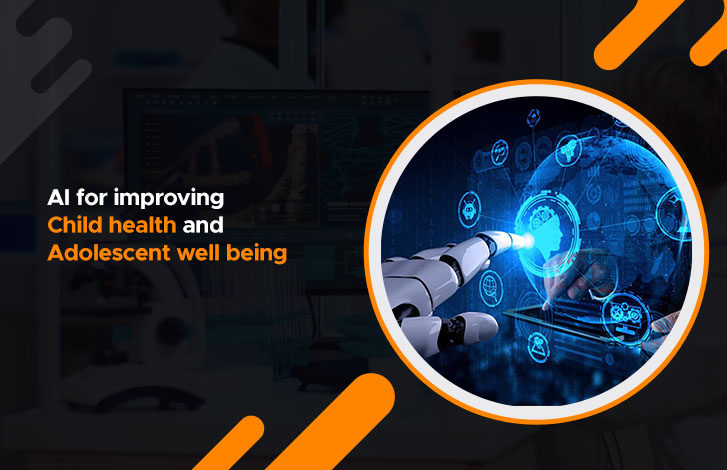Child health and adolescent well-being are crucial for the development and prosperity of individuals, communities, and societies. However, many children and adolescents face multiple challenges and risks that affect their health and well-being, such as poverty, malnutrition, violence, infectious diseases, mental disorders, substance abuse, and environmental hazards. Innovative and effective solutions are needed to address these challenges and risks that can reach and empower children and adolescents in different settings and contexts.
One of the most promising solutions is artificial intelligence (AI), which uses computers to perform tasks that normally require human intelligence, such as learning, reasoning, problem-solving, decision-making, and communication. AI can transform child health and adolescent well-being by providing new possibilities for improving the prevention, diagnosis, treatment, management, and monitoring of various health conditions and outcomes. AI can also enhance the quality, efficiency, accessibility, affordability, and equity of healthcare services and systems for children and adolescents.
How Can AI Benefit Child Health?
AI can benefit child health by providing new ways to prevent, detect, treat, and manage various diseases and disorders that affect children from birth to adolescence. Some of the potential benefits are:
Prevention
AI can help prevent diseases and disorders by providing children and their caregivers with information, education, guidance, and support on healthy behaviors and practices. For example, AI can help promote breastfeeding, immunization, nutrition, hygiene, physical activity, and mental well-being among children and their families. AI can also help identify children at risk of developing certain conditions or complications and provide them with appropriate interventions or referrals.
Diagnosis
AI can help diagnose diseases and disorders by providing children and their caregivers with accurate and timely test results and evidence-based recommendations. For example, AI can help diagnose malaria, pneumonia, tuberculosis, malnutrition, anemia, autism spectrum disorder (ASD), attention deficit hyperactivity disorder (ADHD), or dyslexia among children using various methods such as image analysis, speech recognition, natural language processing, or machine learning. AI can also help diagnose rare genetic disorders by analyzing facial features or genomic data. AI can also help diagnose complex or uncertain cases by integrating and analyzing multiple sources of information and providing differential diagnoses or second opinions.
Treatment
AI can help treat diseases and disorders by providing children and their caregivers with personalized and effective therapies and interventions. For example, AI can help treat cancer, diabetes, asthma, epilepsy, or ADHD in children using various methods such as drug discovery, dosage optimization, treatment recommendation, or neurofeedback. AI can also help treat mental health conditions such as depression, anxiety, or post-traumatic stress disorder (PTSD) among children using various methods such as chatbots, virtual reality, or gamification.
Management
AI can help manage diseases and disorders by providing children and their caregivers with continuous and comprehensive monitoring and support. For example, AI can help manage chronic conditions such as cystic fibrosis, sickle cell disease, or congenital heart disease among children using various methods such as remote sensing, predictive analytics, or alert systems. AI can also help manage developmental disorders such as autism spectrum disorder (ASD), dyslexia, or cerebral palsy among children using various methods such as behavioral analysis, speech synthesis, or motor skill training.
How Can AI Benefit Adolescent Well-being?
AI can benefit adolescent well-being by providing new ways to promote, protect, and improve adolescents’ physical, mental, social, and emotional well-being. Some of the potential benefits are:
Promotion
AI can help promote well-being by providing adolescents and their caregivers with information, education, guidance, and support on healthy lifestyles and practices. For example, AI can help promote sexual and reproductive health, substance use prevention, violence prevention, or civic engagement among adolescents using various methods such as chatbots, online platforms, or peer networks. AI can also help promote positive psychology, resilience, and self-esteem among adolescents using various methods such as gamification, virtual reality, or social media.
Protection
AI can help protect adolescent well-being by providing adolescents and their caregivers with detection, intervention, and referral services for various risks and threats that affect their well-being. For example, AI can help protect adolescents from cyberbullying, online predators, or radicalization using various methods such as sentiment analysis, natural language processing, or facial recognition. AI can also help protect adolescents from self-harm, suicide, or violence using various methods such as predictive analytics, alert systems, or chatbots.
Improvement
AI can help improve well-being by providing adolescents and their caregivers with personalized and effective therapies and interventions for various conditions and challenges affecting their well-being. For example, AI can help improve adolescents’ mental health conditions such as depression, anxiety, or PTSD using various methods such as chatbots, virtual reality, or neurofeedback. AI can also help improve adolescents’ physical health conditions, such as obesity, diabetes, or asthma, using various methods such as wearable devices, mobile apps, or online platforms.
What are the Challenges and Risks of AI for Child Health and Adolescent Well-being?
AI also poses challenges and risks for child health and adolescent well-being that must be addressed and mitigated. Some of the potential challenges and risks are:
Ethical and legal issues
AI can raise ethical and legal issues for child health and adolescent well-being, such as privacy, consent, liability, accountability, and equity. For example, how can children’s and adolescents’ data be protected and used appropriately when using AI? How can children’s and adolescents’ consent be obtained when using AI? Who is responsible if an AI system harms or misleads a child or adolescent? How can children’s and adolescents’ rights be respected and promoted when using AI?
Technical and practical issues
AI can also encounter technical and practical issues for child health and adolescent well-being, such as reliability, validity, usability, interoperability, and scalability. For example, how can children and adolescents trust that AI systems are reliable and valid when dealing with their health and well-being issues? How can they use AI systems easily and comfortably without compromising their safety or privacy? Additionally, how can children and adolescents access AI systems that are compatible and integrated with other systems and devices that they use and how can they benefit from AI systems that are adaptable and scalable to their changing needs and contexts?
Educational and cultural issues
AI can also create educational and cultural issues for child health and adolescent well-being, such as training, evaluation, regulation, and acceptance. For example, how can children and adolescents acquire the necessary skills and knowledge to use AI systems effectively and responsibly? What drives the performance and impact of AI systems on their health and well-being outcomes and quality of life? How can children and adolescents follow the standards and guidelines for using AI systems consistently and ethically and lastly, how can they overcome the barriers and biases that may prevent them from adopting AI systems?
What are the Recommendations for Child Health and Adolescent Well-being to Leverage AI?
AI offers many opportunities for child health and adolescent well-being by providing new possibilities for improving prevention, diagnosis, treatment, management, promotion, protection, and improvement of various health conditions and outcomes. However, it also requires careful consideration of its benefits, challenges, risks, and limitations. To leverage AI responsibly and beneficially, child health and adolescent well-being should follow some recommendations, such as:
Engage in multidisciplinary collaboration
Child health and adolescent well-being should collaborate with other disciplines, such as engineering, computer science, bioethics, law, education, psychology, sociology, etc., to develop, evaluate, and implement AI systems safely, ethically, and effectively. For example, child health and adolescent well-being should work with engineers and computer scientists to design and test AI systems that meet the needs and expectations of children and adolescents. Child health and adolescent well-being should also work with bioethicists and lawyers to address the ethical and legal issues arising from AI systems. Child health and adolescent well-being should also work with educators, psychologists, sociologists, and other experts to understand the developmental, psychological, social, and cultural factors that influence children’s and adolescents’ interactions with AI systems.
Engage in continuous education and evaluation
Child health and adolescent well-being should engage in continuous education and evaluation to keep up with AI systems’ rapid changes and innovations. For example, child health and well-being should train and support children, adolescents, caregivers, and healthcare providers to use AI systems effectively and responsibly. Child health and adolescent well-being should also conduct research and quality improvement projects to measure the performance and impact of AI systems on child health and adolescent well-being outcomes and quality of life. Child health and adolescent well-being should also seek feedback and input from children, adolescents, their caregivers, and other stakeholders to improve the usability and satisfaction of AI systems.
Engage in child-centered design and participation
Child health and adolescent well-being should engage in child-centered design and participation when developing and implementing AI systems. For example, child health and well-being should involve children and adolescents as co-designers, co-researchers, co-evaluators, or co-users of AI systems. When using AI systems, child health and well-being should also respect children’s and adolescents’ preferences, values, goals, rights, and agency. Child health and well-being should also empower children and adolescents to express their opinions, concerns or suggestions about AI systems.
Conclusion
AI is transforming child health and adolescent well-being by offering new possibilities for improving prevention, diagnosis, and treatment. Additionally it helps streamline disease management as well as health promotion, protection, and improvement of various health conditions and outcomes. However, it also requires careful consideration of its benefits, challenges, risks, and limitations. To leverage AI in a responsible and beneficial way, child health and adolescent well-being should follow some recommendations. For examples, engaging in multidisciplinary collaboration, continuous education and evaluation, and child-centered design and participation.







